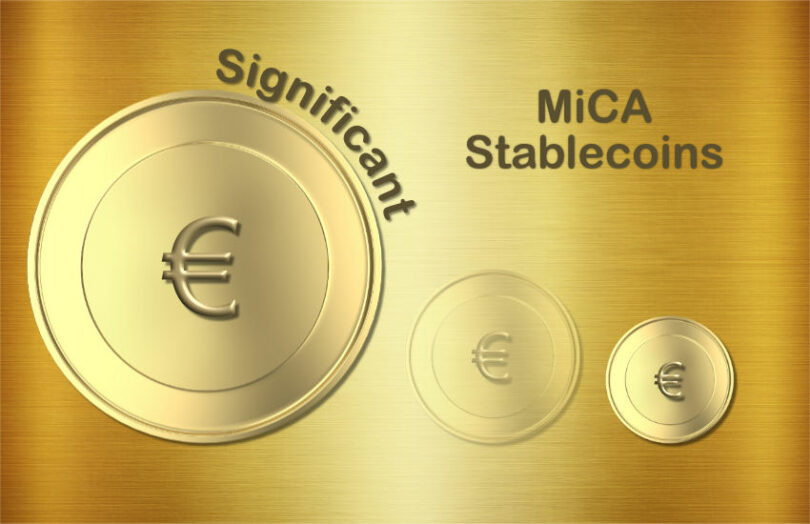A recently published paper proposes altering the European Union’s crypto-asset regulations, MiCA, regarding the treatment of systemic or significant stablecoins. It argues that there’s too much of a cliff effect for a stablecoin to be treated as ‘significant’ suddenly. Plus, it asserts the additional requirements are too onerous. It compares MiCA to other regulations, such as those for global systemically important banks (G-SIBS).
For example, the requirements for G-SIBS are graded across multiple indicators. They are then given an overall score and allocated to one of five buckets. Only JP Morgan is classified in the highest Bucket 4. The higher the bucket, the higher the requirements imposed on the bank.
In contrast, under MiCA, a stablecoin’s classification is not progressive. It’s either significant or not. MiCA sets out several criteria for stablecoins, referred to as e-money tokens or asset-referenced tokens. If a stablecoin ticks three of the boxes below, it is significant.
The significant criteria are:
- number of holders above 10 million
- reserves of more than €5 billion
- more than 2.5 million or €500 million daily transactions
- the issuer is a ‘gatekeeper’ (e.g. BigTech)
- extensive use of a token for payment or remittances on a global scale
- interconnectedness with the financial system
- issuer has another stablecoin.
Impact of a significant stablecoin classification
As a result of a stablecoin being classified as significant, more stringent prudential requirements are imposed on the issuer. Additionally, instead of the national regulator being responsible for oversight, it switches to the European Banking Authority (EBA).
The authors assert that these two issues should be disentangled because they believe the prudential requirements are too demanding.
They give three examples regarding the prudential requirements. The proportion of stablecoin reserves deposited at commercial banks increases from 30% to 60%. This would dent a stablecoin issuer’s revenues. An issuer of a significant stablecoin has higher capital requirements, rising from a minimum of 2% of reserves to 3%. Plus, there’s a requirement for a six-monthly audit rather than an annual one. Given these three factors impact profitability, it’s worth highlighting one of the authors works for USDC and EURC stablecoin issuer Circle.
They note that increasing the proportion of reserve assets to be held at banks from 30% to 60% raises the interconnectedness with the financial system substantially. However, that interconnectedness is viewed as risky. “A formidable regulatory own goal that should be fixed as a matter of urgency,” the authors wrote.
One of the comparisons is with the current proposals published by the UK. The takeaway is that MiCA could classify a couple of current stablecoins as significant. In contrast, the UK has said it would not treat any current stablecoins as systemic.
However, the paper doesn’t mention a key point about the proposed UK regime. Under current proposals, a systemic stablecoin issuer would be required to deposit all reserves at the central bank without compensation. Stablecoin issuers will like the central bank deposits, but rather than earning interest, they would have to find alternative business models. That’s far more onerous that the EU requirements.
Analysis: no debate over the number of holders?
Ledger Insights will soon publish a report on bank-issued stablecoins and tokenized deposits. Sign up for notification of its release.
The first MiCA qualifying criteria for a significant stablecoin is that it has 10 million holders. Whether or not that figure is for EU holders or globally is unclear, but the authors reasonably assume it is the European Union. That’s an important assumption that needs confirmation.
An issue not mentioned is the trickiness of quantifying the number of holders.
Parts of MiCA are based on e-money regulations, where counting the number of holders is far simpler for the likes of PayPal. You probably have one PayPal account, perhaps a second for business.
In contrast, stablecoins are pseudonymous. You could have the same stablecoin in multiple wallets on the same chain or different chains. You might have €5 on Ethereum that isn’t worth moving because of high transaction charges. On cheaper chains, someone could have several 5-cent balances. The regulations set no de minimis balance to be a ‘holder’.
Over time, the number of dormant wallets with small amounts is likely to rise. That happens for e-money accounts, but not to the same degree.
So, there’s potential to overcount the number of holders. But there’s also the possibility of undercounting. A significant proportion of stablecoins are held at exchanges in omnibus wallets. However, the EBA might request that major exchanges provide information regarding the number of holders. Given this criterion is one of the most likely to be ticked, it’s surprising the issue wasn’t raised.






